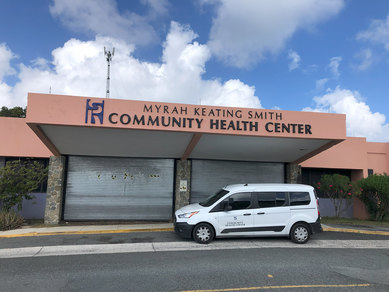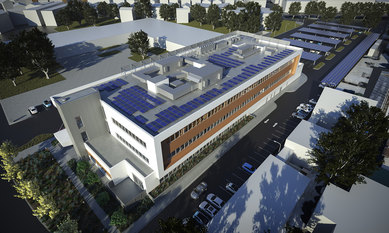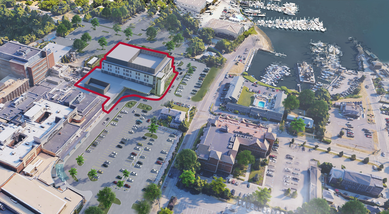Building a Climate-Resilient Healthcare System: What is Your Plan?

We are all familiar with the story of the Three Little Pigs and the Big Bad Wolf. In a slight twist on the story, let’s recast the three little pigs as three different hospitals and the big bad wolf as the threat of a climate-caused disaster.
While the wolf is a one-dimensional risk to the pigs (high wind), climate change is a multi-dimensional threat in the form of extreme temperatures, stronger and more frequent storms, rising sea levels, and wildfires, among others. The hospitals built out of straw and sticks will not have a chance against the devastating impact of climate-fueled events. However, the hospital built out of bricks should prove more resilient against whatever climate change may throw at it.
The wolf proved to be an extraordinary risk to the pigs, just as climate change is an extraordinary and growing risk to our healthcare system. All three home builders knew about the threat, but only one chose to manage the risk and address its vulnerability. But the path for healthcare to contend with climate disasters isn’t as simple as just building ever-sturdier buildings and system redundancies while hoping for the best.
Unlike the first two pigs, who relocated to their sibling’s brick house for protection, it is much harder for neighboring hospitals to transport their patients and operations to a facility that survives an event. No hospital is a stand-alone island in its community. It relies on shared utilities, transportation infrastructure, and communications systems to operate, just as the community relies on it to stay standing. Coordinated solutions for resilience and relocation must be site and environment-specific while working within the larger societal context in which each facility operates and serves.
Healthcare systems can no longer say, "We didn’t know this would happen," when it comes to climate disasters. Hurricane Katrina, Super Storm Sandy, and the western state wildfires are a small sampling of events that have devastated hospitals in the past twenty years. Unprecedented heat waves and extreme precipitation events are also occurring more frequently.
These climate disasters are expected to increase in the future, negatively impacting patient populations and threatening the buildings and campuses they rely on for timely and essential healthcare. How effectively can a hospital help victims of climate disasters if they are out of service due to the same events?
Codes and regulations enacted to ensure that buildings and their systems will withstand the most likely environmental stressors are based on a system that looks backward rather than forward. FEMA and NOAA acknowledge that their floodplain maps, 100- and 500-year rainfall predictions, and hurricane intensity ratings are based on historical data from the past 150 years and must be updated to reflect climate change realities. Similarly, if healthcare systems only look in their rearview mirror, they will fail to see and respond to the coming challenges.
In 2020, Norwood Hospital in Norwood, Massachusetts was permanently closed by a supercell thunderstorm that resulted in a nearly 1000-year rainfall event in 90 minutes.
Just like it’s disrupting the insurance industry, the growing effects of climate change will force authorities having jurisdiction (AHJ) to rethink how they regulate development planning and the design of buildings and infrastructure. Several forward-thinking entities are anticipating the future environment we are facing.
- The City of Cambridge in Massachusetts has created the Resilient Cambridge Plan to address heat, sea-level rise, and flood risks to the city’s population. This document examines anticipated climate-influenced environmental conditions in 2030 and 2070 and outlines strategies to address and mitigate the changing risks.
- Portland, Maine, is developing a new land use code that specifically addresses “fostering climate change resilience.”
- California became the first state to enact climate-reporting legislation in late 2023. SB 261 requires public and private companies with $500 million or more in revenue to report on their climate-related financial risks.
Municipalities or hospitals working alone will not bring about comprehensive results. Healthcare facilities in dense urban and suburban locations are inextricably bound together with their neighborhoods and communities. The resiliency and survival of our healthcare system is a collective action problem requiring a paradigm shift in how the issue is framed and addressed.
This urgent issue must bring a broad cadre of civic, healthcare, business, design and construction leaders together to rethink the resiliency of this essential societal service. A series of disaster planning scenarios must be thoroughly considered, and a multi-stage response plan developed to bring clinicians, first responders and service providers into a coordinated and practiced response.
Healthcare facilities are in the crosshairs of climate change. Proceeding as usual or waiting for updated resilience regulations is no longer an option. Any step taken to protect your hospital building from climate risks is a step forward. Now is not the time to let perfect get in the way of better. Health systems must consider designing beyond the code minimums to improve their facility’s chances of survival to serve those most needing care.

In 2017, The Myrah Keating Smith Health Center on St. John in the US Virgin Islands was put out of service when corroded base attachments of the rooftop equipment failed during Hurricane Maria. The metal boxes were blown across the roof, ripping the EPDM membrane to shreds with their sharp edges and flooding the interior. The largest healthcare facility on the island was permanently closed just when it was needed most.
Foundational Steps You Can Take Now
The low-hanging fruit to address first is aging infrastructure. Rusted, worn-out, and beyond service-life equipment and the aging parts of buildings will be the first to fail in an extreme weather disaster. Perform a facility survey, document infrastructure liabilities, and develop a capital plan to address them on a proactive schedule.
Almost every capital improvement project has the potential to harden your system and make it more resilient. Replacing windows in a bed tower? Install at least one operable unit in each room to allow for natural ventilation if you lose power and AC. Replacing electrical equipment or emergency generators? Elevate these critical systems to a roof or penthouse above a future flood level. Replacing rooftop air handling units or equipment? Secure these units with stainless steel connectors and add redundant hold-down systems to keep them in place.

San Mateo County’s highly resilient Wellness Center is an all-electric facility with extensive on-site renewable energy generation, an energy backup system, and the ability to serve as a place of refuge during disasters and disruptive events.
If your hospital survives a climate disaster but lacks power to operate during and after the event, your hard work has been for naught. First, evaluate the condition, age, and location of backup systems and make them as resilient as possible. Then perform an energy gap analysis to understand what power can be produced in an emergency versus what is needed for basic operations. Develop a discrete capital plan to close the resilience gap, drawing on resources like the U.S. Climate Resilience Toolkit for Building Health Care Sector Resilience.
Lastly, consider on-site power generation for a facility microgrid or installing fuel source redundancy (e.g., diesel and natural gas) for generators to operate beyond a 96-hour maximum. Since no plan can be perfect, understand the conditions that cannot be designed for and make emergency plans accordingly.

Given its close proximity to Lewis Bay and the Atlantic Ocean, the new cancer center and patient tower at Cape Cod Hospital is designed to address sea-level rise, wind-borne projectiles and provide hurricane storm-surge mitigation up to a Category 4.
We know the big, bad wolf of climate change is out there, with a growing risk it could blow your hospital down. Identifying a risk, however, is only a part of developing a solution to it. With a threat as complicated as climate change, how can healthcare systems or individual facilities choose a comprehensive path to follow?
One route would be to sign up for HHS’s Health Sector Climate Pledge. The Pledge provides a framework for healthcare institutions to establish a climate resilience plan while committing to reducing and eliminating emissions and addressing healthcare access and equity issues. This framework sets achievable goals with a schedule, resources, and information to facilitate success.
Climate disasters are unpredictable, but our response to them doesn’t need to be. Hospitals owe their survival to the communities they serve regardless of future disasters. Meeting this challenge requires forward-thinking leaders, bold ideas, and more community-centered planning and collaboration to achieve our shared resilience goals.
This article builds on insights shared during the 2023 Healthcare Design Conference & Expo, in a panel discussion titled "Disasters Happen - Lessons in Mitigation and Recovery." Part two of this Perspectives series explores the critical role that healthcare facility operational performance plays in community resilience and preventative health.